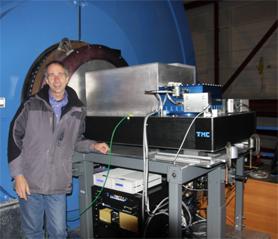
Dr. Brian McLeod (SAO) with the prototype phasing camera at the 6.5m Clay telescope at Las Campanas.
(The following article appeared in the Winter 2013 GMT Newsletter.)
Bringing the universe into focus
Imagine you built the biggest telescope in the world only to discover that its images were out of focus. It's happened before. And historically, whenever a telescope has gotten bigger, the problems have gotten bigger too, something engineers call the "coefficient of difficulty." In order for the GMT to achieve its optimal resolution, as much as 10 times that of the Hubble Space Telescope, there are two major challenges that must be conquered: blurring by the earth’s atmosphere and timing (or "phasing") of the light from a distant object as it reaches each of the GMT’s mirror segments at slightly different intervals. The GMT team and scientists at the Smithsonian are excited with the results of a sophisticated new camera that addresses this phasing challenge.
The problem of our atmosphere
Even on a clear night when you can see the stars, our atmosphere is actually a turbulent swirling mess of air currents and temperature gradients caused by moisture evaporation, solar heating and the earth's rotation. It’s what makes the stars twinkle, which may look pretty, but for astronomers it makes detailed study difficult. For the next generation of giant ground-based telescopes like GMT, engineers needed to correct for this problem. They will accomplish this with a system of computer controlled actuators called Adaptive Optics (AO) that will continuously, but very subtly, change the shape of the seven secondary mirrors, hundreds of times per second, with the assistance of laser guide stars to achieve clarity similar to space-based instruments. But that's just the first part of the challenge.
Timing is everything
While the atmospheric blurring will been corrected with the GMTs sophisticated AO system, the wavelengths of light from extremely distant sources coming through the atmosphere will still hit the individual GMT mirror segments and finally the camera at the base of the telescope at slightly different times. Fixing that timing (or phasing) problem is essential to maintaining what astronomers call coherent light--an analogy being the difference between a turbulent confused sea and a calm sea with regular waves. Because very faint objects to be studied are so enormously far from earth, measuring and correcting these subtle time-of-arrival delays to the various mirror segments requires referencing light from actual stars in the Milky Way instead of an artificial laser-generated source. In addition to deforming the GMT’s adaptive secondary mirror with adaptive optics computers, a very precise type of camera to phase the incoming light from the secondary mirror will be also be essential.
Dr. Brian McLeod and his team at the Smithsonian Astrophysical Observatory have designed and built a camera to demonstrate the phasing strategy for the GMT. The camera uses the faint light of an off-axis star to phase the telescope’s seven segments. The team tested their prototype Phasing Camera on the Magellan Clay Telescope at Las Campanas Observatory, the future home of GMT. By optically masking the Clay Telescope mirror to appear as if light were coming from two adjacent GMT mirror segments, they measured the accuracy with which the Phasing Camera can sense timing errors from the incoming light using stars of different magnitudes. The results confirm that the camera will be sufficiently sensitive to phase the telescope over at least 90% of the sky, allowing the GMT to achieve its promise of unprecedented resolution and usher in an exciting new era of cosmic exploration.
Related News
CfA Selects Contractor for Next Generation Event Horizon Telescope Antennas
Can Cosmic Inflation be Ruled Out?
Astronomers May Have Discovered the First Planet Outside of Our Galaxy
Gravitational Self-Lensing of Massive Black Hole Binaries
Latest Results from Cosmic Microwave Background Measurements
"X-Ray Magnifying Glass" Enhances View of Distant Black Holes
Projects
AstroAI
GMACS
For Scientists